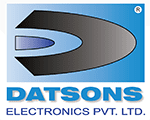K RATED TRANSFORMERS
Harmonic currents generated by nonlinear loads can cause problems in the power system and more particularly in Conventional Transformers designed for Linear loads due to overheating resulting in premature failure.
Any Computer Installation with large number of Computers and peripherals generate / demand large value of Harmonic currents basically for the simple reason that they all have SMPS power supplies at the input with large nonlinear demands and crest factors in the range of 5-7.This results in very large harmonic current demand.Harmonics generate additional heat in the transformers at the input and result in excessive overheating and burning of normal rated transformers.
Merely de-rating Conventional transformers does not solve the problem.
Harmonic currents are currents which have frequencies that are multiples of the fundamental (power supply) frequency i.e. 50Hz. The harmonic currents superimposed on the fundamental current result in the non-sinusoidal current waveforms associated with nonlinear loads.
WHAT IS K FACTOR AND K-RATING?
K factor is property of any load system which is either fully linear or fully non linear harmonic load system or is a combination of the two. The K-Factor number varies with different combinations as given by table below Underwriters laboratory (UL) has devised a rating system to indicate the capability of a transformer to handle harmonic loads. The ratings are described in UL1561 and are known as transformer K-13. K-Factor is a weighting of the harmonic load currents according to their effects on transformer heating, as derived from ANSI/IEEE C57.110. A K-Factor of 1.0 indicates a linear load (no harmonics). The higher the K-Factor, the greater the harmonic heating effects: K-Factor = (Ih)²h² where Ih is the load current at harmonic h, expressed in a per-unit basis such that the total RMS current equals one. This means that the higher the harmonic number its contribution to K-factor is more as in the formulae it is squared.
| LINEAR LOAS SUCH AS MOTORS,HEATERS, INDUCTORS,CAPACITORS INCANESCENT LIGHTING LOADS ETC | NON LINEAR LOAD SUCH AS RECTCAP INPUE ELECTRONIC LOADS VFD'S, CFL LOGHTING LOAD COMPUTERS OR SERVER LOAD | K-FACTOR | |
|---|---|---|---|
| 100% | NONE | K1 | |
| 100% | 60%-80% | K13 | |
| NONE | 100% | K20 |
K RATED TRANSFORMERS-DESIGN FACTORS AND CONSTRUCTIONAL FEATURES
Magnetic design with flux density well below the permissible Bmax for the core material. This provides margin for additional iron losses due to harmonics.
Composite conductor structure design made up of multiple individually insulated parallel conductors of thin rectangular shape which eliminates the predominant skin effect at higher harmonics resulting in significant copper loss including eddy current loss and overheating.
Special coil structure geometries and separated layer of primary and secondory, reduce the magnetic leakage - stray field-and stray eddy current losses significantly.
All the above design and structural features reduce the losses due to harmonics significantly.
However transformers for higher K factor ratings are designed with built-in over sizing to have additional thermal capacity to handle remaining additional losses due to harmonic currents in non - linear loads.
Datsons follow the over sizing levels in the design as discussed later. % over sizing may also be provided as per customeor consultants requirement.
During heat-run testing of K-rated transformers,the loading is done to the oversized ratings, which simulate the additional harmonic losses as expected on non-linear loads under real-time application.
The derating guidelines of UL1561-ANSI 57.110-curves do not apply to transformers with above designs considerations and structure.
Triplen harmonics which form the major part in non linear loads are of zero phase sequence variety and therefore get cumulated in the neutral conductor unlike getting cancelled as with fundamental currents causing excessive heating of neutral conductors and terminals. For K-Factor transformers UL requires that the neutral terminal and connections are sized to accommodate twice the rated current than phase conductor.
With increasing frequency of harmonic currents there is a skin effect of the conductor cross section which results in the current concentrating on the surface of the conductors, in result reducing the effective cross section of the conductors. This causes additional heating of the transformer windings as well as the cables and wires connecting the system.
Datsons make k- rated transformer use multi-core conductors for windings which virtually nullify the skin effect and the resulting increased losses in the windings. It also adapts a rectangular conductor with large aspect ratio such as 5:1 etc resulting elimination of skin effect further.
In order to provide and compensate and provide for core losses due to higher harmonics our K-rated transformers are designed at 20% lower flux density than conventional transformers. This results in an expensive design.K-rated transformers make use of High grade CRGO low loss high permeability core lamination and are designed at reduced Bmax – fluxdensity to accommodate additional iron loss due to harmonic currents Electrolytic grade copper conductors with multiple core cross-sections cancel the eddy losses due to skin effect of higher harmonic currents.
